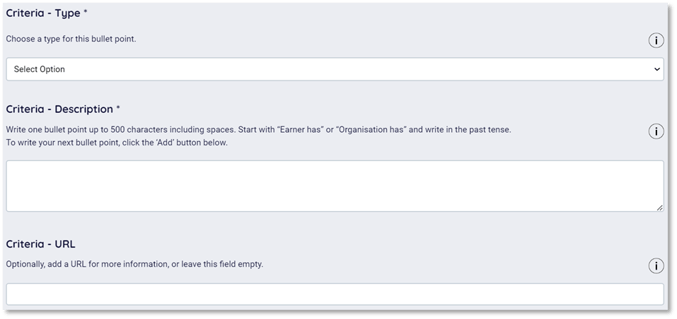Find out more about writing earning criteria in Section 3 of the form in the Badge Zone.
Earning criteria appear as a list of bullet points on your badge when published. This is the place to break down and discuss each important element of what an earner has undertaken to be issued with this badge. This guide covers:
- How to use the Badge Zone to write earning criteria
- What information to include
- Top tips
- Examples - Do's and don'ts
How to use 'Section 3: Earning Criteria' in the Badge Zone
One bullet point is made up of three elements - Type, Description, and URL:

It is mandatory to enter a Type and Description for each bullet point, adding a URL is optional.
The 'Criteria - Description' field should contain only the text for one bullet point, and must not feature bullet points or paragraphs separated by line breaks.

When you have written your first bullet point, create the next by clicking 'Add'.

We recommend writing a minimum of two bullet points per badge to provide value for your earners. Badges containing only one bullet point are often returned as 'Pending' with a request for more detail as they do not pass the 'Stranger Test' during Quality Assurance.
What information to include
Your earning criteria section should describe the knowledge, skills, attitudes and values that an individual or organisation has gained or demonstrated during your activity, and should clearly explain what an earner has achieved, completed or learned about.
|
Think "ASO": A – Action. What did the earner do? S – Skill. How does the action relate to a skill? O – Outcome. What did this achieve? Result:
Don't worry if you don't write in this order, it might make sense to mix this up, e.g.:
|
Top Tips
We focus earning criteria on the individual earner or organisation rather than plurals. This is because the earning criteria section is the part of the badge that is easiest to copy and paste onto CVs, applications and cover letters, so it really helps the earner relate back to their own experience and clearly articulate what they have done in the past.
| ✅If your badge is for individuals, start each criteria description with “Earner has…” |
| ✅If your badge is for organisations, start each criteria description with “Organisation has...” |
| ✅Write a minimum of two earning criteria per badge to ensure sufficient detail and references to skills. |
| ✅Always refer to things that have happened in the past, e.g. "Earner has done something" not "Earner will do something". |
| ✅Make sure your criteria descriptions pass ‘The Stranger Test’ and can be easily understood by anyone that might be unfamiliar with your organisation or activities. |
| ✅Make sure to reference any skills tags you enter into Section 4. |
| ✅Refer to specific tasks, platforms, software, equipment etc. to help your earners to demonstrate their experience. |
| ✅Don’t be afraid to go into detail. Each bullet point can contain up to 500 characters including spaces, so you have plenty of room. |
| ❌ Avoid including bullet points or line breaks in description fields. |
| ❌ Avoid indirect terms or mixed tenses such as “Earner will have”, “Earner is able”, or “Earner can”. |
Examples – Dos & Don’ts:
|
❌Earner has participated in a gardening course. This gives little detail around the purpose of the course or what skills or knowledge earners gain by taking part. ✅Earner has participated in a 2-day course to increase their knowledge of horticulture and develop skills in gardening. |
|
❌Earner has completed a quiz about gardening. This gives little detail about the quiz content or what learning outcomes the earner is completing by taking part. ✅Earner has demonstrated their understanding of gardening by successfully passing a quiz to identify common garden plants. |
|
❌Earner has demonstrated adaptability. This does not include information on what the earner has done to demonstrate this skill. ✅Earner has demonstrated adaptability by identifying and learning a new way to complete [task]. |
|
❌Earner has demonstrated an understanding of Photoshop. This does not include context for how the earner has demonstrated their understanding. ✅Earner has demonstrated their understanding of Photoshop by using the software to create a new [insert visual asset e.g. leaflet / art / logo etc.] |
|
❌Earner will have demonstrated computer literacy by carrying out a range of workplace tasks on Microsoft Word. "Will have" is a mixed tense that can create confusion about whether or not an earner has carried out a task when they are issued with the badge. ✅Earner has demonstrated computer literacy by carrying out a range of workplace tasks on Microsoft Word. |
|
❌Earner is able to perform a theatrical monologue to a live audience. "Is able" does not directly state whether an earner has done something, or whether they have learnt about how to do it. An earner may have the tools to perform their monologue, but this does not mean that they have performed it in real world context. This can often cause confusion about which layer of the RSA Badge Standard a badge should be published at. ✅Earner has increased their understanding of live performance by memorising a theatrical monologue.(Participate layer) OR ✅Earner has demonstrated the ability to confidently deliver a theatrical monologue by performing in front of a live audience. (Demonstrate layer) |
/Black%20and%20white%20-%20png/Real_ideas_logo_RGB_White.png?height=120&name=Real_ideas_logo_RGB_White.png)